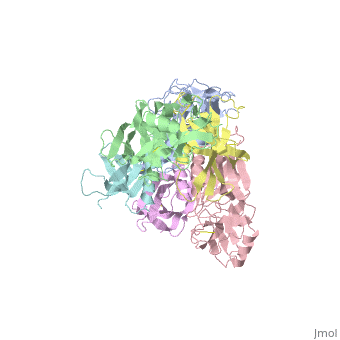Pertussis Toxin-ATP Complex
From Proteopedia
| Line 10: | Line 10: | ||
==Pertussis Toxin activation== | ==Pertussis Toxin activation== | ||
| - | <scene name='Pertussis_Toxin-ATP_Complex/Subunit_1/2'>S1 (chains A,G)</scene>, <scene name='Pertussis_Toxin-ATP_Complex/Subunit_2/2'>S2 (chains B,H)</scene>,<scene name='Pertussis_Toxin-ATP_Complex/Subunit_3/2'>S3 (chainsC,I)</scene> | + | <scene name='Pertussis_Toxin-ATP_Complex/Subunit_1/2'>S1 (chains A,G)</scene>, <scene name='Pertussis_Toxin-ATP_Complex/Subunit_2/2'>S2 (chains B,H)</scene>,<scene name='Pertussis_Toxin-ATP_Complex/Subunit_3/2'>S3 (chainsC,I)</scene>, <scene name='Pertussis_Toxin-ATP_Complex/Subunit_4/2'>S4 (chains D,E,J,K)</scene>, <scene name='Pertussis_Toxin-ATP_Complex/Subunit_5/3'>S5 (chains F,L)</scene> |
| + | |||
==Mechanism of pathogenesis== | ==Mechanism of pathogenesis== | ||
Revision as of 21:34, 2 November 2011
|
|
Contents |
introduction
Protussis Toxins is a major virulence factor of Bordetella pertussis that cause whooping cough. Whooping cough, also known as pertusis, is a highly contagious bacterial disease caused by the bacteria Bordetella pertussis. This disease had been characterized by severe cough that has been documented to cause subconjunctival hemorrhages, rib fractures, hernias, fainting and vertebral artery dissection. The pertussis toxin has been characterized as being a AB toxin meaning that there are 2 subunits: A subunit possesses the enzyme activity and the B subunit it the receptor binding portion. Together this AB toxin colonizes the respiratory tract and becomes activated by destabilization due to the binding of ATP.
structure
The protussis toxin is a AB5 toxin consisting of a six-component protein complex. With that in mind, this protein is a hexamer containing a catalytic (S1) subunit that is tightly associated with the pentameric cell-binding component (B-oligomer). The S1 component is a single subunit while the B-oligomer is a pentamer composed of four types of subunits: S2,S3, two copies of S4, and S5. This B subnit is what binds to the terminal sialic acid residues.
Pertussis Toxin activation
, ,, ,

